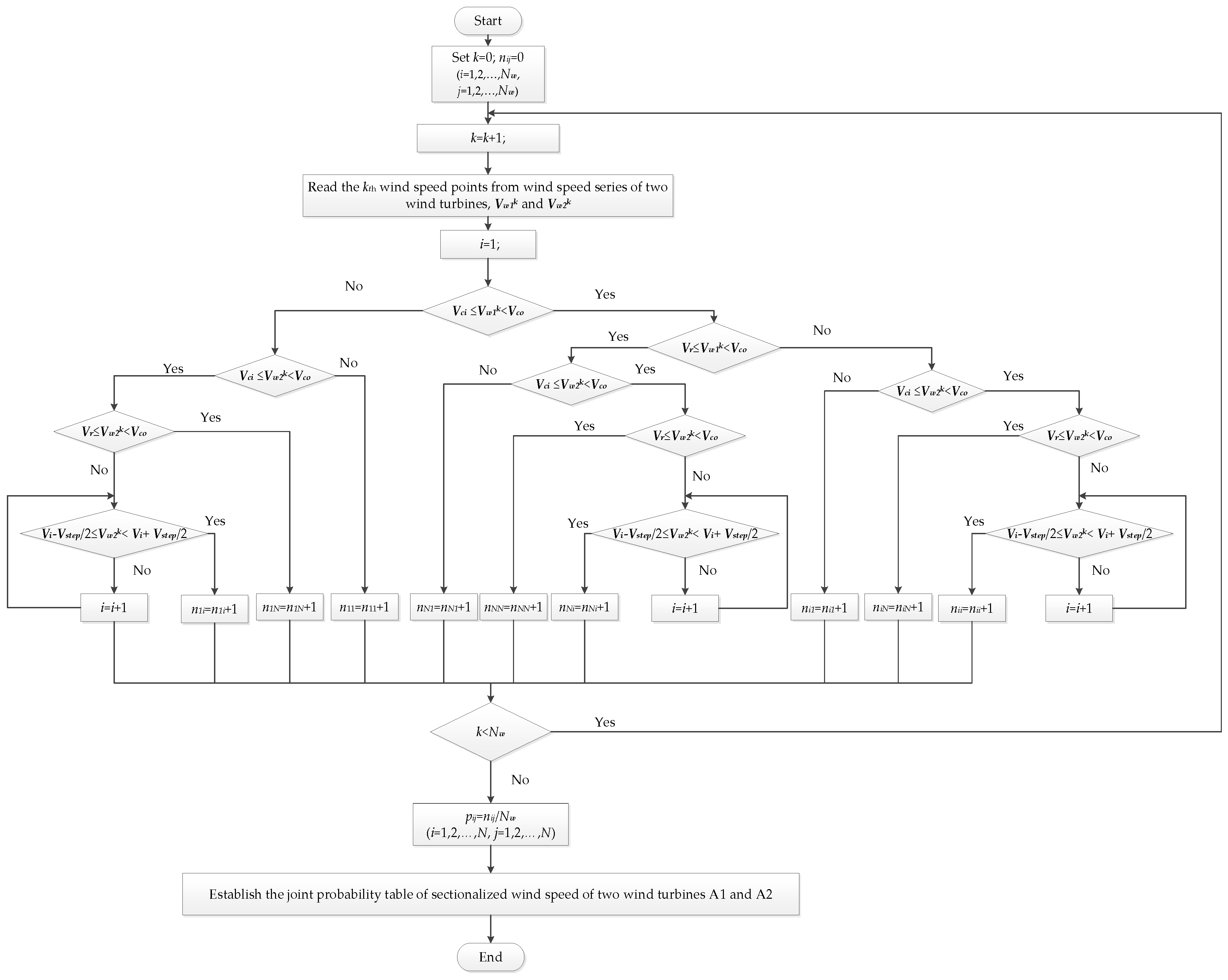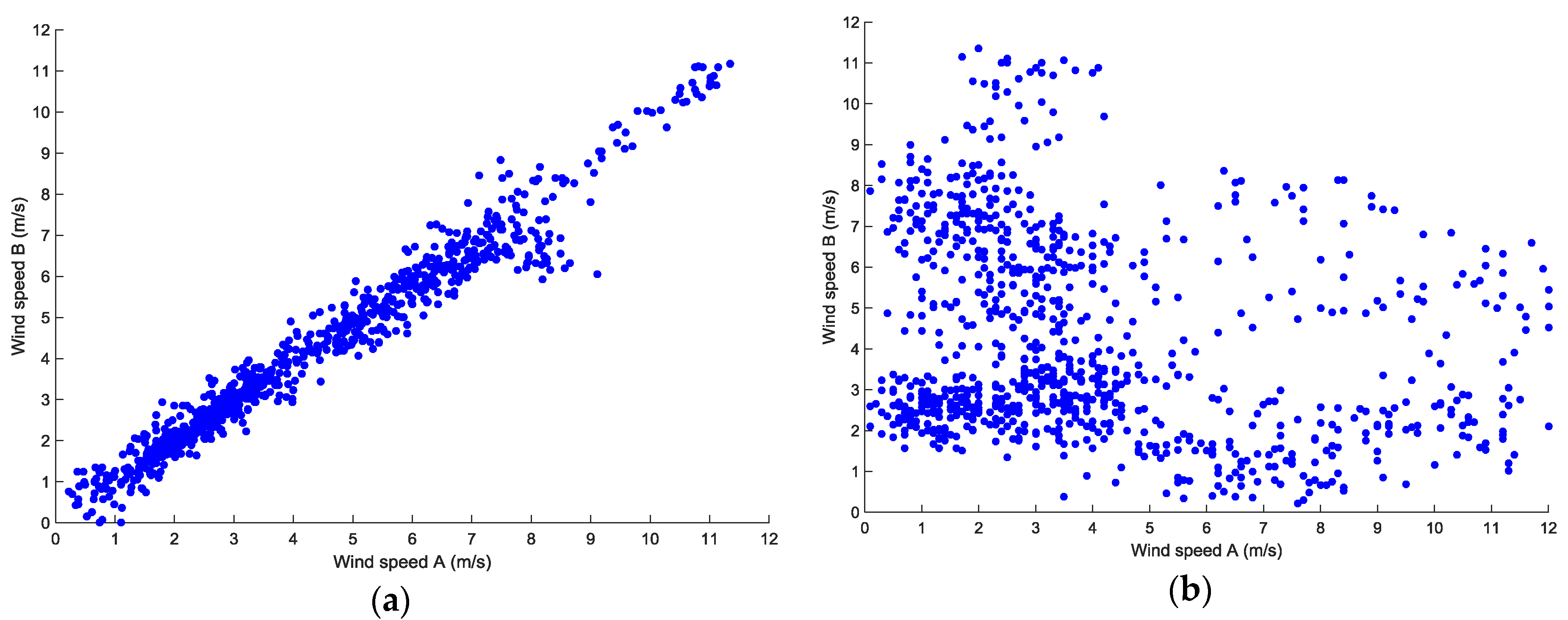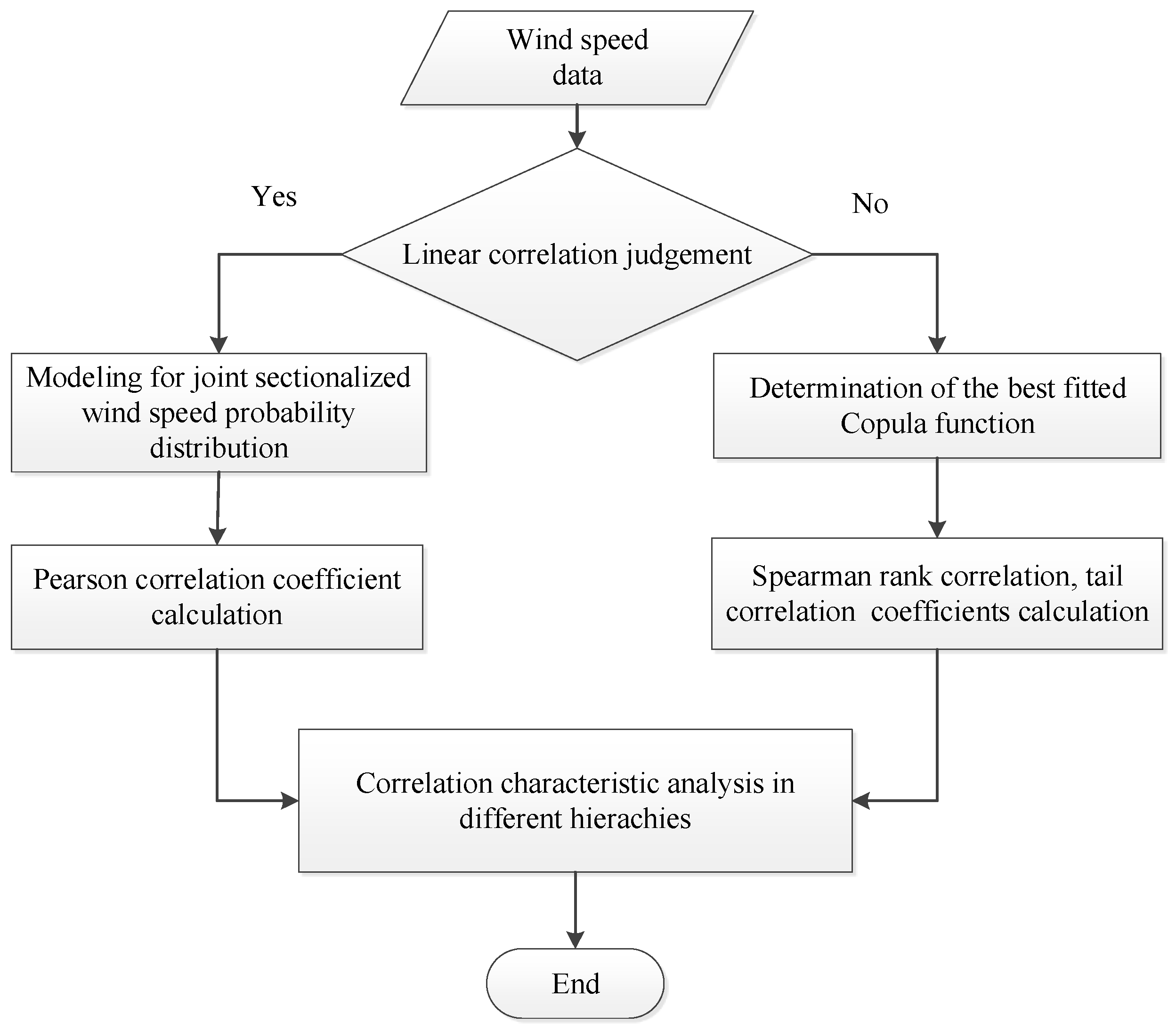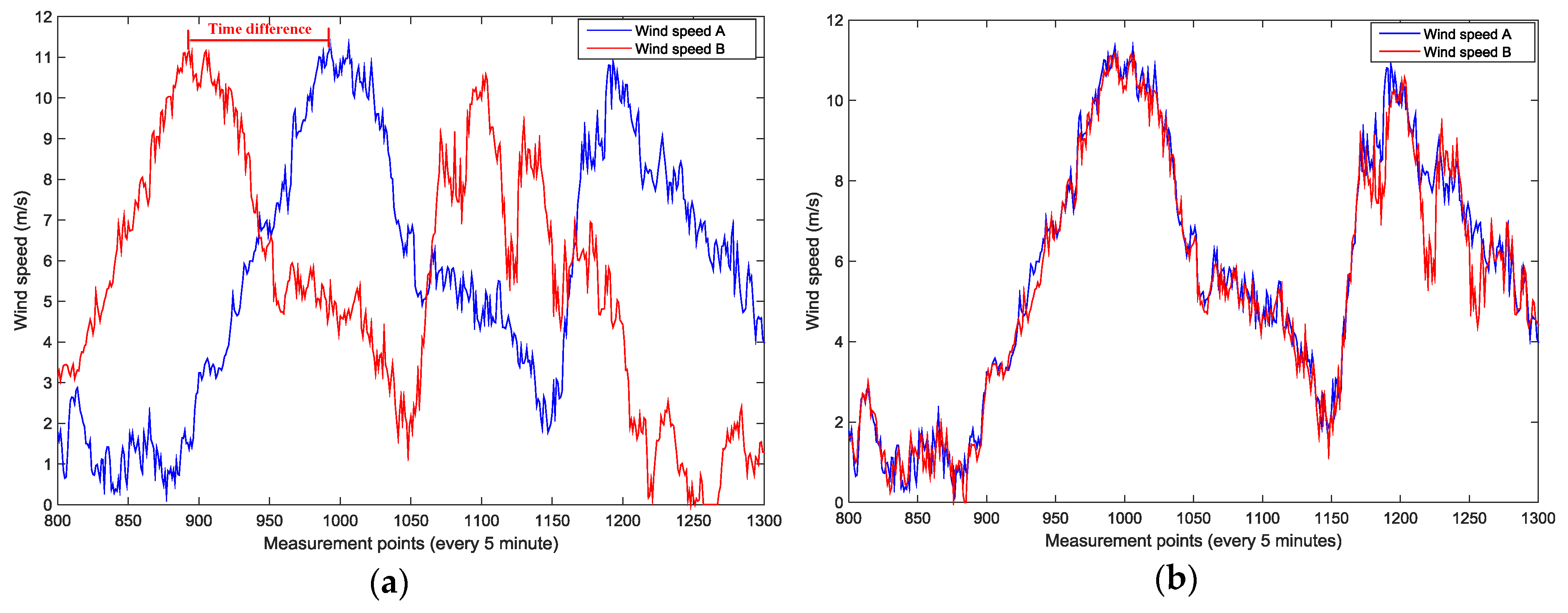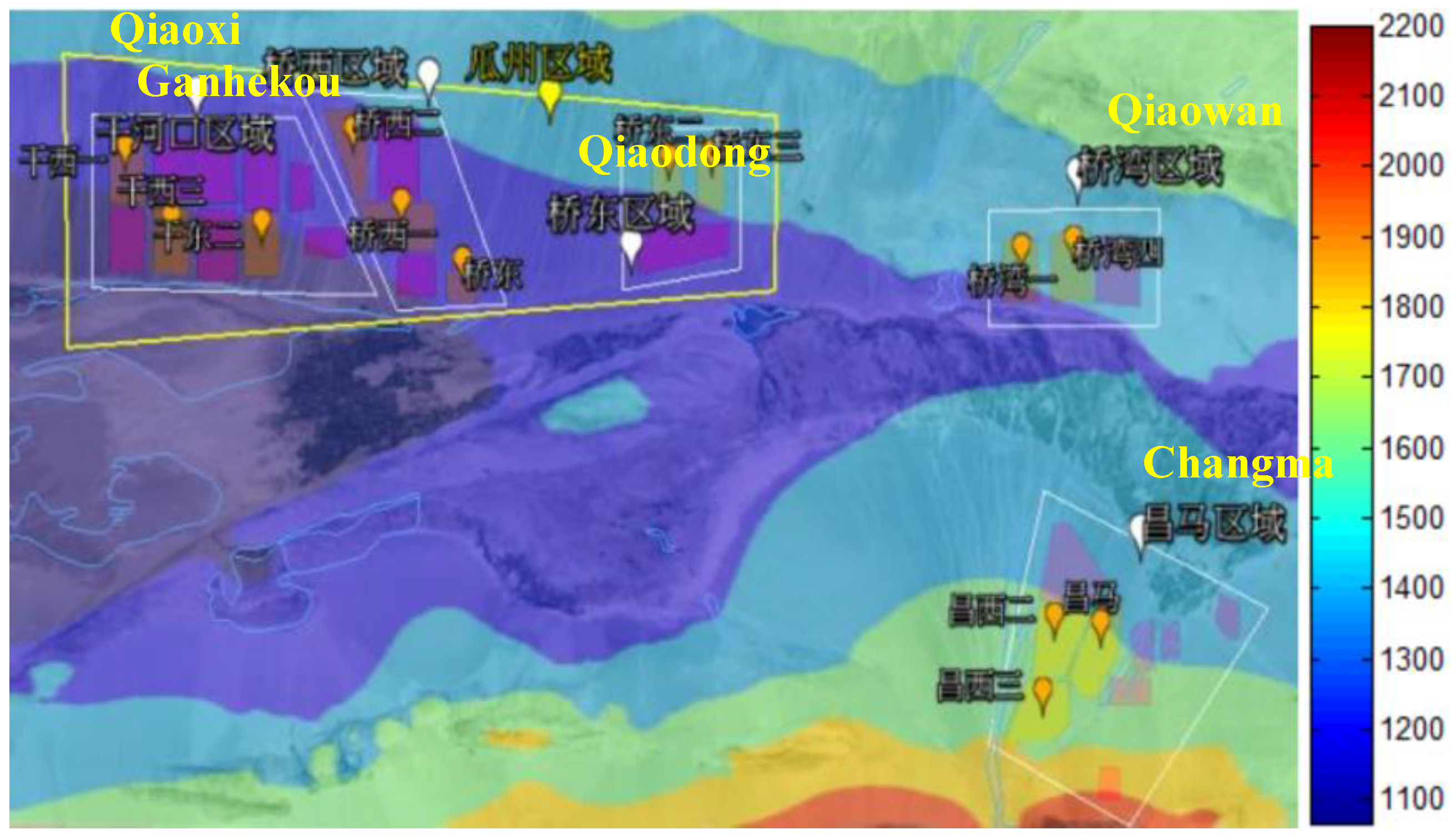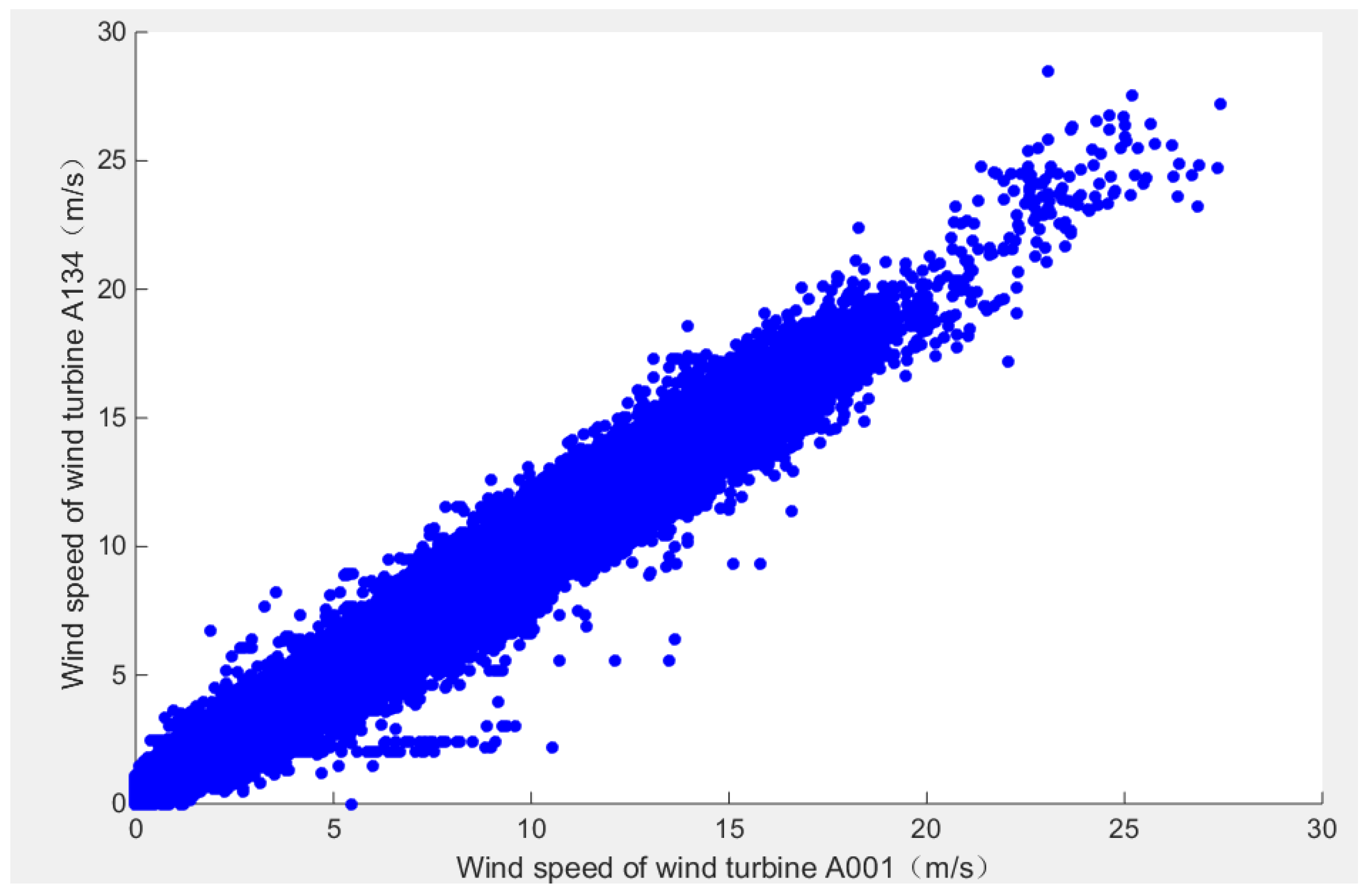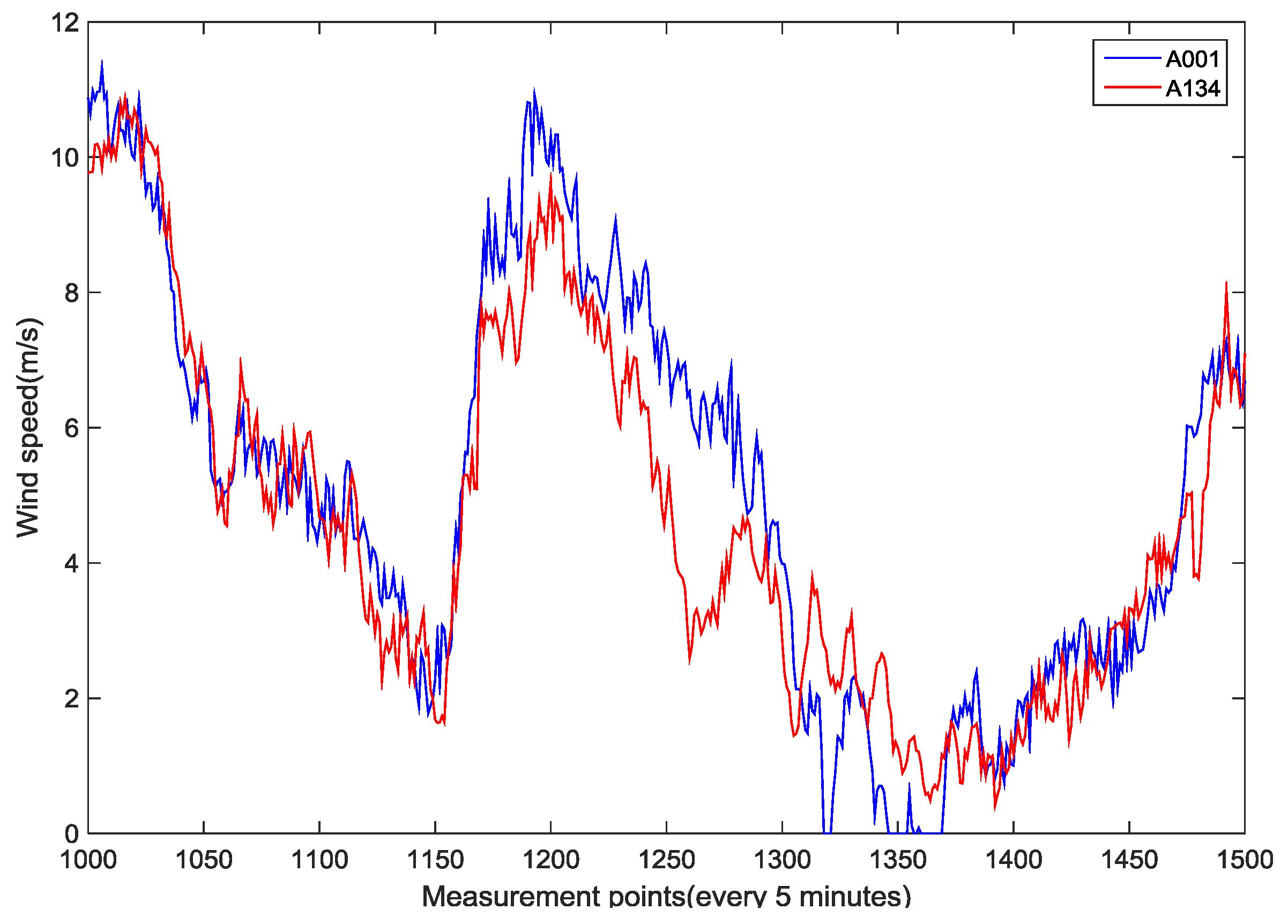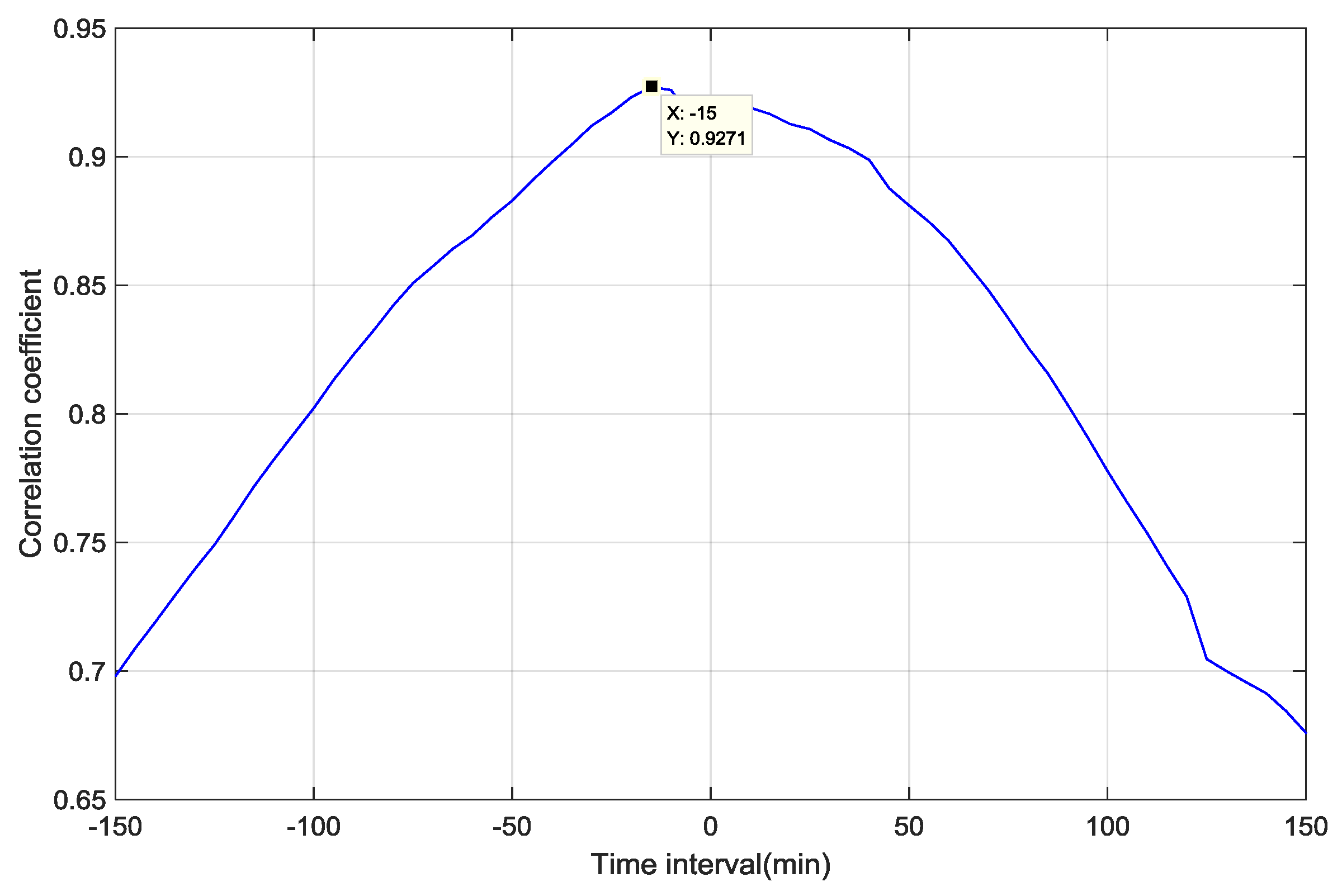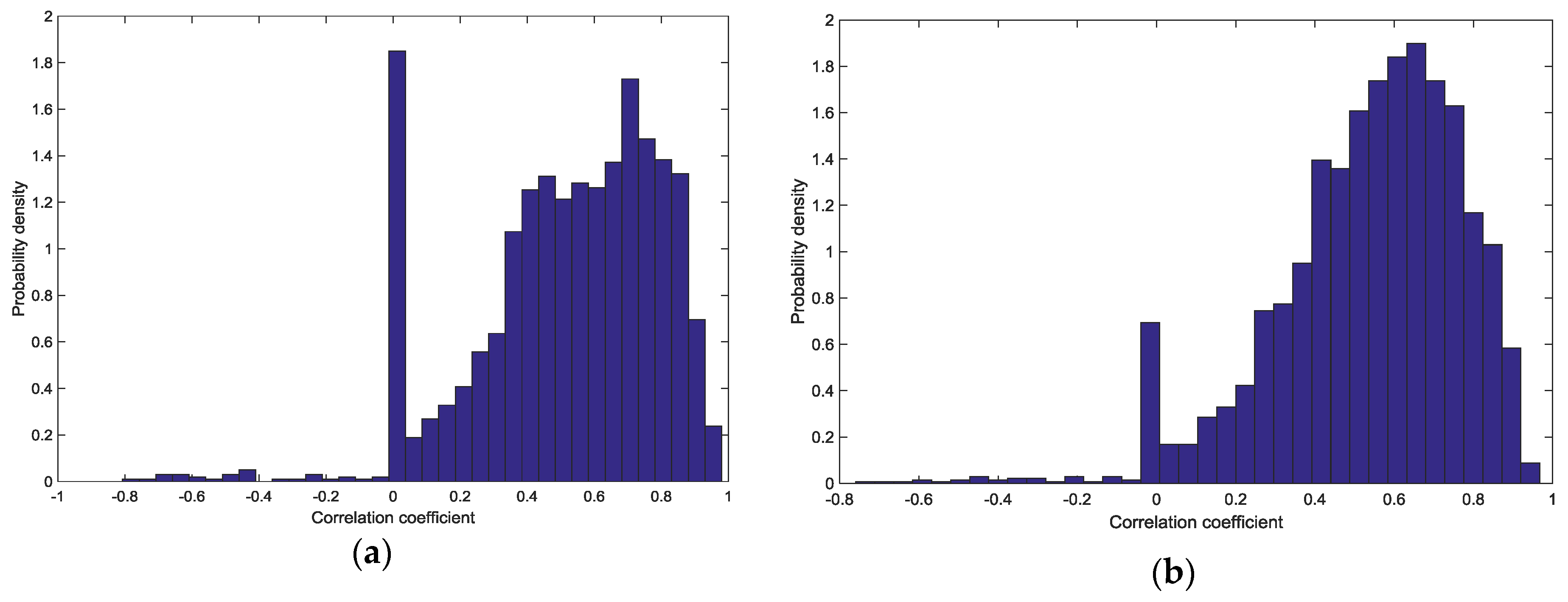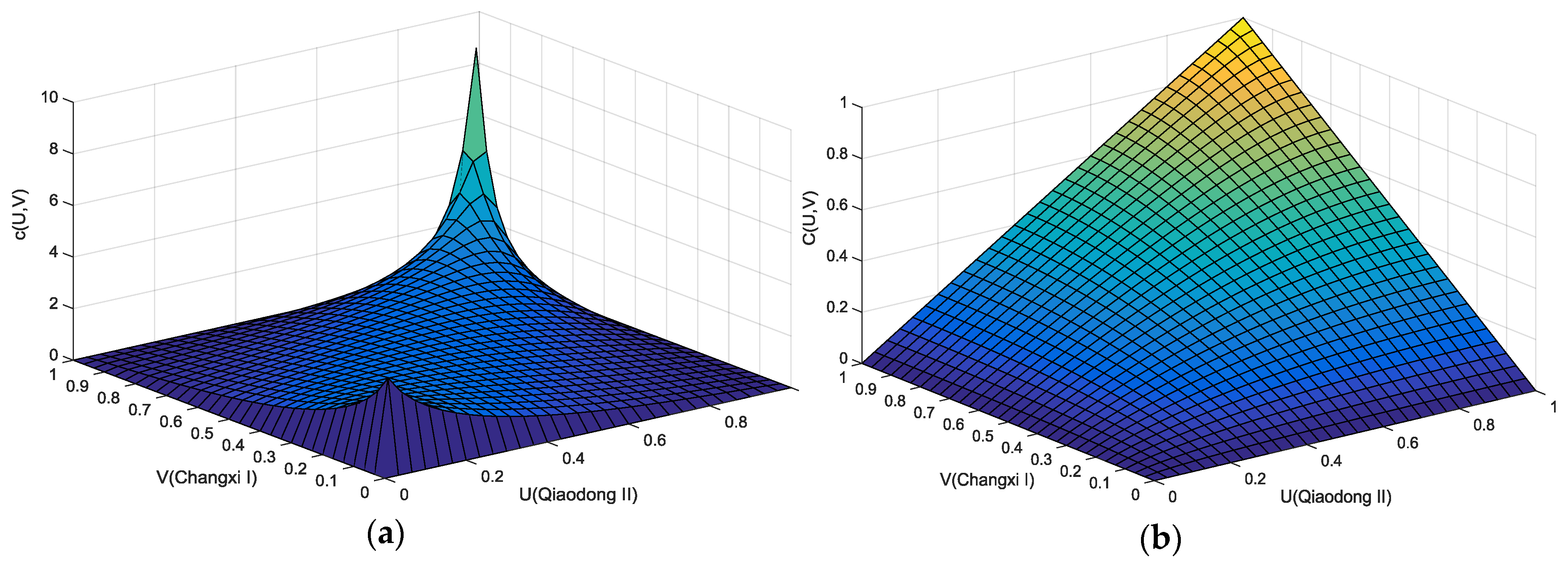1. Introduction
As one of the most promising renewable energies and effective solution for environmental degradation for years to come, wind energy is an alternative to fossil fuels popularly promoted in many countries. Especially in the northwest of China, the Hexi Corridor, known for its abundant wind and solar resources, has continuously developed large-scale wind power bases. In addition to the intermittency and uncertainty of wind energy, wind speed correlation information is of great necessity for power system planning and operation [
1,
2,
3,
4,
5,
6] with geographically distributed wind farms driven by the presence of increasing scale of wind power bases.
In past years, the study of correlation of wind speed and wind power in wind farms which was applied in unit commitment [
7], reliability evaluation [
8], and economic dispatch and so on [
9] has provided important insights for power system planning and operation. Though some achievements have been made with general knowledge of correlation characteristics in wind speed or wind power, researchers have only focused on the relationships at the wind farm or wind site levels [
10,
11] but failed to consider the internal relationship among wind turbines located in the same wind farms. In addition, the correlation characteristics among the wind farm and its wind turbines is also needed to study to explore the internal wind power variation of wind turbines contributing to their wind farm. Without considering the internal relationship introduced above in the wind speed or power forecast model [
12,
13], it may lead to the bias that causes power imbalances and increases the risk during operation.
In general, correlation coefficients [
14] were applied to measure the degree of correlation of targets. The Pearson coefficient is commonly used as a measure of the linear dependence of variables. Applying it to the wind energy field, [
15] presented a two-stage model for wind speed series considering autocorrelation and cross-correlation based on Pearson coefficient. However, the Pearson correlation coefficient only describes linear correlations but cannot cope with nonlinear correlation problems. Alternatively, Copula theory has recently been applied to wind speed and wind power as a way of modeling nonlinear dependence structures. A rank correlation coefficient [
16], namely the Spearman coefficient was extensively utilized to measure nonlinear correlation of wind speed. Reference [
17] proposed to evaluate the fit of a class of Copulas–Archimedean Copulas to model wind speed correlation. Reference [
18] separated multivariate wind speed time series into dependence structure modeled by Copulas and subsequently utilized an ARMA model to represent each univariate time series. However, the tail correlation of wind speed among wind farms, which commonly exists in the wind speed joint distribution, has attracted less attention.
Against the background of Jiuquan in northwest China, where the biggest 10 GW wind power base is under construction, the need to further investigate the interrelationship among wind turbines within the wind farm as well as among wind farms within the wind site persists is driven by the facts of their geographical adjacency and randomness in wind energy.
This paper addresses the analysis for correlation characteristics of wind speed in different geographical hierarchies that is, among wind turbines, within the wind farm and its wind turbines, and among wind farms. According to the linear or nonlinear correlation condition in each geographical hierarchy, the use of the Pearson coefficient for linear correlations, and Spearman and tail coefficients for nonlinear correlations were judged, respectively. In this paper, the proposed approach is to analyze the correlation characteristics of wind speed quantitatively and qualitatively based on data from the Wind Speed Dataset of the Gansu Wind Power Technology Center, China. The correlation characteristic analysis in different geographical hierarchies will provide detailed correlation information to improve the accuracy of wind speed or power prediction. It is implemented to evaluate the wind unit siting and wind farm planning, especially for China’s concentrated wind power integration. They is certainly high interest in production probability simulation, which contributes to power system planning and risk assessments. We note that while in this work the proposed approach is applied to the Gansu Wind Power Base, it can be easily extended to other cases in different regions.
The remainder of the paper is organized as follows:
Section 2 introduces the linear correlation analysis including joint sectionalized wind speed probability modeling and linear correlation coefficient for correlation measurement. In addition, nonlinear correlation analysis including Copula theory and its nonlinear correlation coefficients are given in
Section 3. The proposed methodology for analysis of the correlation characteristics of wind speed in different hierarchies is described in
Section 4. Case studies on the correlation characteristics of wind speed among wind turbines, among wind farm and its wind turbines, and among wind farms are discussed in
Section 5. Conclusions are given in
Section 6.
2. Linear Correlation Analysis
Correlations can be classified as linear correlations and nonlinear correlations. Linear correlations, which refer to a straight line correlation between two variables, characterize the degree of correlation to which larger wind speed x values go with larger speed y values and smaller x values go with smaller y values in the paired wind data sets. In this section, the method to establish a joint sectionalized wind speed probability distribution will be introduced. The joint sectionalized probability distribution is appropriate for linear correlations in a qualitative way. Then, the Pearson coefficient that can be used to quantitatively measure the linear correlation between the individual values of wind speed series at different locations.
2.1. Modeling for Joint Sectionalized Wind Speed Probability Distribution
At the beginning of a correlation analysis, it is necessary to qualitatively identify whether the correlation is linear or not. Thus historical wind speeds are treated by dividing wind speeds into several sections, which could provide an efficient way to avoid using huge amounts of measured wind speed data. Based on the segmentation, a joint sectionalized wind speed probability distribution at different locations (e.g., in wind turbines or wind farms) can be established. Furthermore, correlation of wind speed among locations can be analyzed quantitatively.
2.1.1. Wind Speed Sectionalizing
Values of wind speed series at one location are divided into
N sections within the wind speed variation range, so that
N sectionalized wind speed points are obtained in the middle of each section. The wind speed values are then classified into the section in which their nearest sectionalized point are located.
Figure 1 illustrates the sectionalizing process.
As the wind power is zero when the wind speed is below the cut-in wind speed or above the cut-out wind speed, wind speed values within these ranges are regarded to be the equivalent cut-in wind speed value, marked as the first sectionalized wind speed value:
where
V1 represents the first sectionalized wind speed value; and
Vci represents the cut-in wind speed.
When the wind speed value is between rated wind speed and cut-out wind speed, the wind power reaches to the rated value. Thus, the
Nth sectionalized wind speed value can be marked as:
where
VN represents the
Nth sectionalized value, and
Vr represents the rated wind speed.
When the wind speed is between the cut-in wind speed and rated wind speed, wind power varies with wind speed. Therefore, other sectionalized wind speed points are:
where
Vstep represents the wind speed interval between two adjacent sectionalized wind speed points; and
Vi represents the
ith sectionalized points.
2.1.2. Joint Sectionalized Probability Distribution of Wind Speeds
After sectionalizing the wind speed, the probability of the wind speeds divided into the corresponding section is obtained. By establishing the joint probability of wind speeds at different locations, correlation of wind speed among those locations can be intuitively described in an efficient way. Suppose that one wishes to model the joint sectionalized wind speed probability of two turbines A1 and A2, each with one year of
Nw measured wind speed points. Based on the sectionalized wind speeds of each wind turbine, the joint sectionalized wind speed probability can be modeled as
Figure 2 shows. The detailed steps of modeling are as follows:
- Step 1:
Set k = 0, nij = 0 (i = 1, 2, …, Nw, j = 1, 2, …, Nw);
- Step 2:
k = k + 1. Read the kth wind speed point from wind speed series of two wind turbines, Vw1k and Vw2k;
- Step 3:
If
Vw1k <
Vci or
Vw1k ≥
Vco, then
Vw1k equivalently locates on the sectionalized point
V1,
- Step 3.1:
If Vw2k < Vci or Vw2k ≥ Vco, then Vw2k equivalently locates on the sectionalized point V1, then n11 = n11 + 1;
- Step 3.2:
If Vr ≤ Vw2k < Vco, Vw2k equivalently locates on the sectionalized point VN, then n1N = n1N + 1;
- Step 3.3:
If Vi − Vstep/2 ≤ Vw2k < Vi + Vstep/2, Vw2k equivalently locates on the sectionalized point Vi, then n1i = n1i + 1;
- Step 4:
If
Vr ≤
Vw1k <
Vco, then
Vw2k equivalently locates on the sectionalized point
VN,
- Step 4.1:
If Vw2k < Vci or Vw2k ≥ Vco, Vw2k equivalently locates on the sectionalized point V1, then nN1 = nN1 + 1;
- Step 4.2:
If Vr ≤ Vw2k < Vco, Vw2k equivalently locates on the sectionalized point VN, then nNN = nNN + 1;
- Step 4.3:
If Vi − Vstep/2 ≤ Vw2k < Vi + Vstep/2, Vw2k equivalently locates on the sectionalized point Vi, then nNi = nNi + 1;
- Step 5:
If
Vi −
Vstep/2 ≤
Vw1k <
Vi +
Vstep/2, then
Vw2k equivalently locates on the sectionalized point
Vi,
- Step 5.1:
If Vw2k < Vci or Vw2k ≥ Vco, Vw2k equivalently locates on the sectionalized point V1, then ni1 = ni1 + 1;
- Step 5.2:
If Vr ≤ Vw2k < Vco, Vw2k equivalently locates on the sectionalized point VN, then niN = niN + 1;
- Step 5.3:
If Vi − Vstep/2 ≤ Vw2k < Vi + Vstep/2, Vw2k equivalently locates on the sectionalized point Vi, then nii = nii + 1;
- Step 6:
If k < Nw, go to Step 2; otherwise, go to Step 7;
- Step 7:
The joint probability of sectionalized wind speed is pij = (i = 1, 2, …, Nw, j = 1, 2, …, Nw);
- Step 8:
Establish the joint probability table of sectionalized wind speed of two wind turbines A1 and A2, shown as
Table 1.
Joint probabilities on the diagonal line in the table show the possibility of the same contemporaneous wind speed values of two wind turbines, providing a qualitative way to judge whether wind speed relationship of two turbines is linear correlation or not. The method for modeling the joint probability of sectionalized wind speed of different wind turbines can also be applied to the analysis for wind farms.
2.2. Linear Correlation Coefficient
The Pearson correlation coefficient is generally used to measure the linear dependency of random variables. Let
X,
Y be two random variables with their expectation
E(
X) and
E(
Y). Suppose variance
D(
X) > 0 and
D(
Y) > 0, Pearson correlation coefficient
r is defined as [
19]:
where cov(
X,
Y) is covariance of
X and
Y.
The Pearson coefficient r is between −1 and 1. The absolute value of correlation coefficient r measures the strength of the linear relationship between X and Y. The value of |r| equal to 1 means that there is a perfect linear relation. The linear correlation of two variables gets stronger when |r| gets close to 1; and they have no relation when r is 0. When r > 0 we say that the data pairs are positively correlated; and when r < 0 we say that they are negatively correlated.
Though Pearson coefficients are often straightforward to calculate, they cannot properly describe correlation of variables with heavy-tailed distribution, for example, observations for wind speed. Besides, independence of two random variables implies they are uncorrelated (r(X,Y) = 0) but a zero correlation does not in general imply independence. Only in the case of the multivariate normal distribution is it permissible to interpret uncorrelated as implying independence. Besides, it fails to deal with nonlinear correlation problems due to its limited properties and conditions.
5. Case Study
5.1. Case Background
Jiuquan in northwest China, is under construction for the biggest 10 GW wind power base in Gansu Province, which is known for its abundant wind energy resources. Wind energies are concentrated in this area due to the well-known Hexi Corridor with its 160 km length and 100 km width. As shown in
Figure 6, the Gansu wind area is divided into five regions including Ganhekou, Qiaoxi, Qiaodong, Qiaowan and Changma all located in the Jiuquan Wind Power Base. The wind characteristics in Ganhekou, Qiaoxi and Qiaodong regions are similar due to their similar terrains in the north, while the winds are different in the Changma region located in the southeast. In this paper, the wind speed correlation characteristics between the Qiaodong and Changma regions are investigated as a typical case.
To explore the correlation under different hierarchies, that is among wind turbines, among the farm and its wind turbines, and among wind farms, wind speed measurements characterizing farms located in each of the two geographical regions of interest as well as turbines located in each of farms of interest are clearly needed.
For the needs of the present paper, the wind farm Qiaodong II with its 134 wind turbines (Qiaodong Region) and Changxi I (Changma Region) with its 65 wind turbines are considered and summarized in
Table 2. In this paper, wind speed series measured every 5 min were provided.
5.2. Correlation Characteristics of Wind Speed among Wind Turbines
In the goal of exploration of the correlation characteristics of wind speed among wind turbines located in the same geographical region, a pair of wind turbines A001 and A134, both located in wind farm Qiaodong II were taken as an example using the proposed method.
Using wind speed series in time ranging from 2015.1.1 to 2015.12.30, the linear correlation of wind speed between A001 and A134 is clearly shown in
Figure 7. It shows that points of wind speed are observed to scatter near the straight line. After sectionalizing the wind speed series of each wind turbine, the joint probability of sectionalized wind speed of two turbines was established as
Table 3, further describing their linear correlation in quantities. The number of sectionalized joints of wind speed was set as 10 according to practical experience.
It is observed that the large joint probability values (marked in blue) are almost on the diagonal line, which indicates that the instantaneous wind speeds of A001 and A134 are close. In addition, the strong linear correlation of wind speed between A001 and A134 is shown in
Figure 7 and
Table 3, apparently because they are adjacent in geographical locations in the same wind farm sharing a similar wind regime. Thus, their linear correlation characteristics can be expressed by a Pearson correlation calculation.
As each wind turbine is at a distance ranging from 200 m to 10 km from others in the Qiaodong II wind farm, the wind speed of each wind turbine may vary differently due to the distance. To analyze the temporal-geographical correlation of wind speed between wind turbines, the wind speeds in time series of two wind turbines in a certain period were treated by shifting several time intervals from the wind speed series of wind turbine A001 and keeping that of A134 unchanged. The Pearson coefficient, which tests the correlation of the two treated wind speed series, was then calculated to examine the distance relationship between A001 and A134. The original measured wind speed series of A001 and A134 in a certain period is shown in
Figure 8, which describes a time difference between two wind speeds series.
Then the Pearson coefficients were calculated in different shifted time intervals.
Figure 9 depicts the variation of correlation coefficient values corresponding to different shifted intervals. The shifted time of A001 wind speed series ranges from −150 min to +150 min. Note that “–“ means the shifted wind speed series of A001 is lagging behind that of A134 while “+” means the shifted series of A001 is ahead of that of A134. The peak value of the Pearson coefficient is reached at 0.9271 when the time intervals of A001 are shifted backward by 15 min, which means that the two have a strong correlation after time shifting. The time difference “15 min” can be intuitively explained by their geographical distance. Indeed, the distance where the wind at a mean speed (5 m/s) goes from A134 to A001 lasting for 15 min is exactly examined to be their actual distance (4–5 km), which indicates A134 was upstream of A001 during that period.
Wind speeds of 134 wind turbines for one year in the Qiaodong II wind farm were treated by calculating the correlation coefficients between any two turbines.
Figure 10 describes a downtrend of correlation coefficient values as the distance of two corresponding turbines is increasing. It is observed that there is a strong correlation between any two wind turbines in the same wind farm shown in
Figure 10, where all the correlation coefficients are higher than 0.9 even if the furthest distance is 9 km. By linear fitting, the linear relationship between the Pearson coefficients and geographical distance is as follows:
where
d represents the distance between two wind turbines;
S represents the correlation coefficient value; and the goodness of fit is 0.6544. This knowledge leads to a recommendation to enlarge the balancing areas, and to construct transmission paths in diverse locations.
The investigation for correlation characteristics in time and geography can be applied to evaluate the wind unit siting and wind farm planning, which is of significance in practice and engineering.
5.3. Correlation Characteristics of Wind Speed among a Wind Farm and Its Wind Turbines
The correlation characteristics of wind speed among a wind farm and its wind turbines on short and long time scales were investigated with one year of collected wind speeds in a wind farm. We take the Qiaodong II wind farm and its 134 wind turbines as an study example. Periods of experimental wind speed in time series were considered as 0.5 h, 1 h for the short time scale and 6 h, 12 h for the long time scale.
To reflect the overall wind speed variation in the Qiaodong II area, the wind speed of the wind farm was treated by averaging wind speeds of all wind turbines in the same wind farm. As demonstrated in
Section 4.2, wind turbines in the same wind farm have strong correlations with each other, so the Pearson coefficients were calculated at 0.5 h, 1 h, 6 h and 12 h time intervals, respectively, based on the wind speed series of the Qiaodong II wind farm and its wind turbines.
As one of results among cases, the correlation coefficient between wind farm Qiaodong II and wind turbine A015 was calculated. Consequently, its probability density distributions were obtained as seen in
Figure 11, where the coefficient value “−1” means a negative correlation between the wind speed series of the wind farm and wind turbine A015 while the value “1” indicates a positive correlation between the two. Note that the overall blue area of each subplot is 1, which is the total probability of the correlation coefficient in the specific time interval. It is observed that the Pearson coefficients for short time scales (subplot (a) and (b)) range from −1 to 1 while those of long time scales (subplot (c) and (d)) range from 0 to 1.
As the time interval gets longer, the wind speed series in time of the wind farm and its wind turbines tend to get positively correlated, which indicates that variation and change of wind speed series tends to coincide in a long period (over 1 h). And as the time interval gets shorter, the Pearson coefficient values distribute between a negative correlation (−1) and a positive correlation (1), indicating a volatility and randomness in wind speed series of wind turbines located in the wind farm in a short period (under 1 h).
5.4. Correlation Characteristics of Wind Speed Among Wind Farms
Wind speed series in the Qiaodong II and Changxi I wind farms were analyzed as an example to investigate the correlation characteristics of wind speed among wind farms. At a distance of 80 km, the wind speed of the two wind farms is not linearly correlated, which is shown in
Figure 12 where wind speed points are scattered randomly and disorderly.
However,
Figure 13 shows a dependent variation tendency of the wind speed series of two wind farms, and their nonlinear correlation deserves to be investigated using copula analysis.
An asymmetric tail is shown in
Figure 14 with a heavy upper tail and a light lower tail. After constructing the empirical Copula function, the Euclidean distances of common Copulas (Gauss, t, Gumbel, etc.) to the empirical Copula are calculated, respectively, to determine the best-fitted Copula function. The less the Euclidean distance of the specific Copula function to the empirical copula distribution is, the better the Copula function fits the actual joint distribution. As the results in
Table 4 show, the Gumbel_Copula with its minimum Euclidean distance to the empirical Copula fits the best compared to other common copulas. Therefore, the Gumbel_Copula was chosen as the fitted-best copula to analyze the correlation of wind speed series between the Qiaodong II and Changxi I wind farms.
After estimating the parameters of the Gumbel function, the Gumbel_Copula probability density function was obtained as seen in
Figure 15 where a “J” shaped feature is consistent with the bivariate frequency histogram in
Figure 14. The Gumbel_Copula, which sensitively captures the upper tail variation of the correlation, indicates that the wind speed of the two wind farms has a strong dependence at the upper tail but an asymptotic independence at the lower tail in the joint probabilistic distribution.
Correlation coefficients are calculated to test the nonlinear correlation of wind speeds between the Qiaodong II and Changxi I wind farms. As the results listed in
Table 5 show, the Spearman rank coefficient is 0.5952, indicating that when the wind speed of Qiaodong II is increasing, the difference between the probability of increase in wind speed of Changxi I and the probability of decrease in wind speed of Changxi I is 0.5952. This illustrates that there is a moderate correlation of wind speed between the Qiaodong II and Changxi I wind farms.
The upper and lower tail coefficients λup and λlo are calculated when the threshold value is 0.95 and 0.05, respectively. It means that when the wind speed of Qiaodong II is over 20.3 m/s corresponding to “0.95” of its wind speed cumulative probability, the probability of the wind speed in Changxi I over 22.6 m/s corresponding to “0.95” of its cumulative probability is 0.8952. The heavy upper tail shows a strong wind speed correlation between the two wind farms in the high wind speed region. In low wind speed region which is under 3 m/s corresponding to “0.05” of either wind speed cumulative probability, the wind speeds of two farms tend to become independent.
The dependence structure of wind speed between Qiaodong II and Changxi I and their tail correlation are described in an intuitive way in the Gumbel_Copula function. It could provide detailed correlation information for a wind speed forecasting model, which can be transformed according to wind power curves to improve the wind power prediction accuracy.

